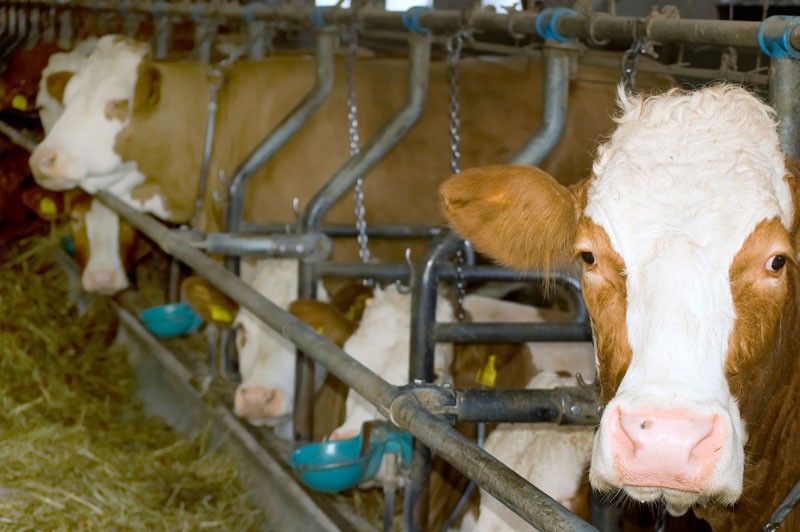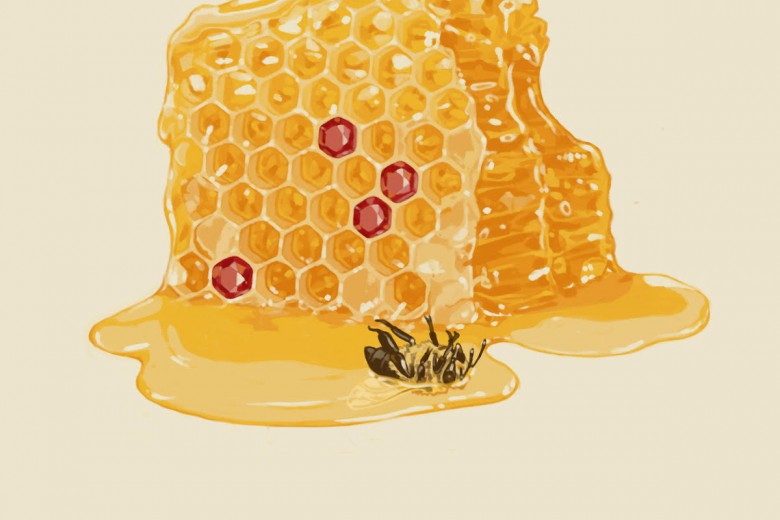
Many Canadians first learned of flesh-eating disease or necrotizing fasciitis in 1994 when then-Bloc Québécois leader Lucien Bouchard lost his leg, and very nearly his life, to the affliction. Media reports of Bouchard’s brush with death described the disease as “extremely rare.” It was at the time, but has since become more commonplace. Up until 1994 there were only about 40 cases of necrotizing fasciitis recorded worldwide, while today between 90 and 200 cases are reported in Canada alone every year.
Curiously, the explanation for the sudden and remarkable rise in the number of patients suffering from flesh-eating disease may in large part lie in the very flesh we eat, bred by our livestock industry. Recent research suggests this system is a major contributor to the recent rise in antibiotic-resistant bacteria plaguing our hospitals. And these bacteria, although not traditionally associated with flesh-eating disease, are now blamed for a growing percentage of cases.
What is flesh-eating disease?
Flesh-eating disease doesn’t actually consume flesh; rather, it kills flesh when toxins produced by bacteria destroy skin and muscle. If left untreated, the infection will spread to the bloodstream, leading to organ failure and often death within days. Because of the toxicity and rapid onset of the disease, treatment generally involves surgical removal of the infected flesh and the administration of antibiotics intravenously.
In the case of Bouchard, diagnosis and treatment came too late to save his leg, but was at least able to save his life.
Historically, most cases of flesh-eating disease developed in patients with weakened immune systems who fell prey to streptococcus infections acquired in hospital. Since 2001, however, hospitals have increasingly reported incidents of flesh-eating disease brought on by methicillin-resistant Staphylococcus aureus (MRSA) infections – bacteria able to resist traditional antibiotic treatments.
This should come as no surprise, as the number of reported MRSA infections has increased enormously over the last 20 years in lockstep with a corresponding transformation in livestock production from small family farms to large-scale factory farms ushered in first by the Canada-U.S. Free Trade Agreement in 1989, and later bolstered by NAFTA in 1994. Researchers with the Canadian Nosocomial Infection Surveillance Program released a survey in March that found reported cases of patients infected or colonized by MRSA in Canadian hospitals increased 17-fold between 1995 and 2007. Today in the US the lives of more than 18,000 people are claimed by MRSA-related infection every year, exceeding AIDS-related deaths.
The vast majority of MRSA infections, however, are not fatal. Patients merely develop boils, sometimes accompanied by a fever or rash, that can be treated effectively, albeit expensively, with recently developed antibiotics. However, pneumonia, widespread infection and toxic shock syndrome can also result from more virulent strains.
MRSA infections inevitably tax limited health care resources and jeopardize patient care. The Public Health Agency of Canada estimated direct health care costs attributable to MRSA at $82 million in 2004 and predicted the total would rise to $129 million by 2010.
Researchers have divided the many strains of antibiotic-resistant bacteria into two groups: community-associated and hospital-associated. As their names suggest, hospital-associated strains are those that originate within health care facilities, while community-associated strains originate outside. Community-associated MRSA strains are generally more virulent, more dangerous and until recently, occurred much less frequently. In 1995, community-associated MRSA strains accounted for just six per cent of reported cases in Canada, rising to 23 per cent by 2007. Now, recent estimates have the figure as high as 40 per cent. Worse, many of these more virulent strains have now established themselves in hospitals and other health care facilities. Among the elderly, sick and vulnerable, they are exceedingly difficult to eradicate.
“It is still mostly a hospital-acquired infection,” Dr. Andrew Simor, chief of microbiology and infectious diseases at the Sunnybrook Health Sciences Centre in Toronto, told the CBC recently. Over the past five years, MRSA infections in children and young adults outside hospitals have dramatically increased, he explained.
“We need to continue to be vigilant in controlling this infection and developing more effective interventions to control the rapid emergence of more virulent community-associated MRSA strains from the community that have now been introduced into hospital settings in Canada.”
Health care professionals, policy-makers and researchers are understandably alarmed by this trend and keen to identify its source. Recent research aimed at explaining it is pointing the finger at factory farms.
Resistance on the rise
When Alexander Fleming was awarded the Nobel prize in 1945 for his part in discovering penicillin, the first antibiotic, he remarked that it was easy to produce microbes resistant to it: simply expose them to doses insufficient to kill them. This is now standard operating procedure at every factory farm in North America.
Cows, pigs, chickens and other livestock consume roughly 70 per cent of all antibiotics manufactured in the U.S. – an estimated 12 million kilograms per year. Canadian statistics are not maintained but likely closely reflect U.S. numbers because, thanks to NAFTA, agricultural practices here are largely the same. This antibiotic regime is called “subtherapeutic” because it is not administered to treat disease, but rather to prevent it. As a result, crowded, filthy conditions that would otherwise result in disease outbreaks and unacceptable losses for producers have instead become the norm.
“These are feed additives. It’s like using antibiotics as hair dye,” Ellen Silbergeld, a professor of environmental health sciences at the Bloomberg School of Public Health and one of several researchers at Johns Hopkins University studying the links between industrial agriculture and resistant microbes, explained to the Baltimore Chronicle last year. “Our food safety system is a shambles. This is a situation that is widely recognized by the World Health Organization, the American Medical Association, and by others, and nothing happens!”
It’s a model of Darwinian selection for stronger and more resistant bacteria on a massive scale. And there is a growing body of evidence suggesting that the anticipated result is in fact occurring with sobering consequences for human health.
Here in Canada, the connection between resistant microbes and industrial livestock production was first documented in a 2007 study published in Veterinary Microbiology that examined the incidence of MRSA in pig farms in Ontario. The study reported MRSA at 45 per cent of farms sampled and in a quarter of the pigs.
Evidence linking the spread of MRSA to industrial agriculture is accumulating rapidly. The Veterinary Microbiology report came on the heels of a study that found Dutch pig farmers were 760 times more likely to be MRSA carriers than the public at large and a Scientific American report that found that 12 per cent of pork on supermarket shelves in Holland tested positive for MRSA. Also in 2007, a Centers for Disease Control and Prevention study demonstrated that a strain of MRSA originating from one animal reservoir was responsible for 20 per cent of all MRSA cases in Holland. More recently, a study in Iowa revealed similar numbers to those documented in the Ontario report: 45 per cent of farmers and 49 per cent of pigs tested positive for MRSA.
Canada’s policy vacuum
The increasing occurrence of resistant bacteria is far from limited to MRSA and hog production. Subtherapeutic use of antibiotics in cattle, dairy, hog, poultry, egg and other livestock is contributing to antibiotic resistance among microbes such as salmonella, c. difficile, pneumonia, E. coli and many others.
Six years ago the World Health Organization reported that the evidence clearly linked dangerously resistant bacteria to non-human use of antimicrobials and called the situation “a crisis which threatens to rob the world of opportunities to treat or cure many infectious diseases.” It also recommended governments legislate an end to non-therapeutic administration of antibiotics in agriculture. In 2006, the European Union adopted a ban on the practice.
Meanwhile, in Canada, despite escalating health care costs and complications from antibiotic resistant microbes and the increasing ineffectiveness of many classes of traditional antibiotics, there is no such ban in place and none under consideration. In fact, in 2009 the federal government disbanded the 10-year-old Canadian Committee on Antibiotic Resistance and has ignored pleas from health experts and scientists to establish a Canadian Centre for Antimicrobial Resistance.
Since 2002, the Public Health Agency of Canada, however, has funded the Canadian Integrated Program for Antimicrobial Resistance Surveillance (CIPARS), charged with tracking antimicrobial-resistant bacteria in food and on farms, to the tune of $3 million annually. The program has competently fulfilled its mandate, yet even when the data gathered by CIPARS identifies agricultural practices that are likely contributing to antibiotic resistance, government agencies charged with intervention – Health Canada, the Public Health Agency of Canada and the Canadian Food Inspection Agency – have proven unwilling or unable to act decisively.
Take the case of the widespread and unapproved use of cephalosporin antibiotics by Canadian chicken hatcheries that, according to CIPARS, was likely responsible for a rise in human resistance to that class of antibiotics. CIPARS looked specifically at Ceftiofur – an antibiotic that hatcheries were injecting into eggs to prevent future infection outbreaks among chickens. The practice, designated “off-label” because it never received formal approval by Health Canada, was suspected to be responsible for increased resistance to cephalosporin antibiotics in humans. In 2005, resistance levels in Quebec were so high that hatcheries in the province agreed to voluntarily suspend Ceftiofur injections. Within months CIPARS noted a 60 per cent decline in resistance among hatchery birds, a 30 per cent decline among samples of chicken sold at supermarkets and a 45 per cent decline in human resistance.
“The CIPARS data appears to be answering the question about a linkage between usage of antibiotics in animals and human resistance,” Jim Hutchinson, chair of the Canadian Committee on Antibiotic Resistance remarked to the Canadian Medical Association Journal in July 2009 – just days before the Public Health Agency announced it was disbanding his organization by cancelling its $300,000 annual budget.
Other researchers interpreted the CIPARS data more succinctly. “Taken in context with all the other knowledge we have, anyone still opposing a link between antibiotic use in food animal production and direct human health impact does so for other reasons than science,” Frank Aarestrup, a specialist on antibiotic resistance with the Technical University of Denmark, told the Canadian Medical Association Journal last year.
And how did Health Canada respond when presented with the evidence? It added an unenforceable warning against off-label usage to Ceftiofur packaging. Soon after, a Canadian Medical Association Journal report confirmed that the off-label practice of routinely injecting eggs with Ceftiofur continues in Quebec, Ontario and British Columbia today. Recent reports from CIPARS have noted that poultry, retail chicken and human resistance to cephalosporin antibiotics is on the rise once again.
The toothless response from regulators suggests that while they are willing to concede the point that agricultural use of antibiotics presents human health concerns, the health of Canadian people is less important than the perceived competitive advantage antibiotics offer to the nation’s industrial livestock producers.
Ironically, Sweden, Denmark and other countries have demonstrated that if overcrowding is reduced and infection control techniques are implemented, abandoning subtherapeutic antibiotic regimes in livestock production has little, if any, impact on the bottom line. In the wake of Sweden’s 1986 ban on antibiotics, the net increase in cost to consumers was estimated at 12 cents per kilo for retail meat. In Denmark, the World Health Organization reported that as of 2003, the net costs associated with productivity losses incurred by removing antimicrobial growth promoters from pig and poultry production were an estimated €1.04 per pig produced, with zero net cost for poultry. This translates into an increase in pig production costs of slightly more than one per cent.
Is 12 cents a kilo too much to pay to help maintain the life-saving potential of antibiotics? Thanks to this extraordinary but delicate class of medication, cures for tuberculosis, scarlet fever, diphtheria, syphilis, gonorrhea, meningitis and dozens of other diseases and infections that have plagued humanity for centuries now exist. Are we willing to invite a return to the days when tuberculosis alone killed one in every four people in the western hemisphere for the sake of a slightly cheaper pork chop?
What you can do:
There are measures we can take to safeguard the effectiveness of antibiotics, which coincidentally will also protect our health, improve conditions for livestock and preserve the environment.
Start by eating less meat. When choosing meat, buy certified organic or from a source you are confident supports farmers who raise livestock without using antibiotics. An excellent resource for finding antibiotic-free meat, dairy, and eggs in Canada is Beyond Factory Farming’s Buy-Local Food Directory (see www.beyondfactoryfarming.org).
Write and lobby politicians and the appropriate government agencies to implement an immediate ban on the use of antibiotics as animal growth promoters and enhancers of animal feed efficiency, particularly where those classes of antibiotics are of high importance for human therapeutic use. Also, demand that these classes of drugs undergo immediate review and possible restriction for therapeutic use in animals. Insist that non-human antibiotic use and the incidence of resistant microbes in humans, livestock, meat, eggs and dairy products be subject to rigorous monitoring, surveillance and reporting. Ask your friends and neighbours to do the same.






